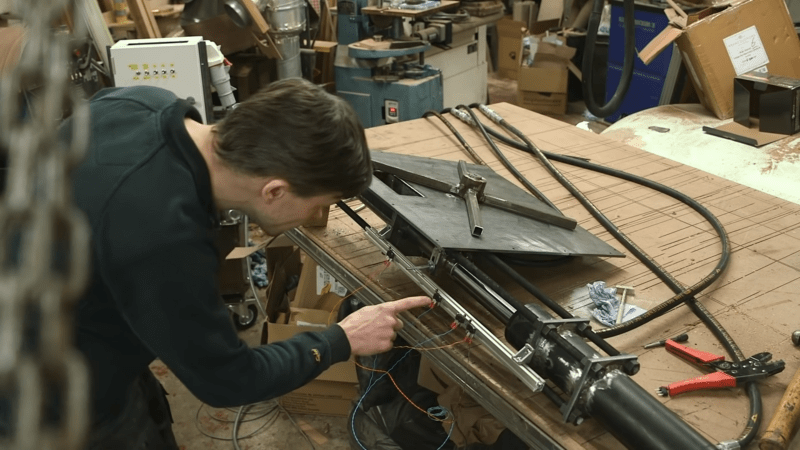
When you are a life long carpenter with an amazing workshop, you’re going to make a lot of saw dust, and managing its collection and storage poses quite a challenge. [Russ] from [New Yorkshire Workshop] built an impressive Briquette press to handle the problem.
It’s a hydraulic press that ingests saw dust and spits out compressed briquettes ready for fueling his rocket mass heater. The build starts with a batch of custom, laser cut steel parts received from Fractory. The heart of the machine is a 300 mm stroke hydraulic cylinder with a beefy 40 mm rod. The cylinder had to be taken apart so that the laser cut mounting flanges could be welded, slowly so as not to deform the cylinder. The intake feed tube was cut from a piece of 40 mm bore seamless tube. A window was cut in the feed tube and funnel parts were welded to this cutout. The feed tube assembly is then finished off with a pair of mounting flanges. The feed tube assembly is in turn welded to the main feed plate which will form the base of the saw dust container. The hydraulic cylinder assembly is mated to the feed tube assembly using a set of massive M10 high tensile class 10.9 threaded rods. The push rod is a length of 40 mm diameter mild steel bar stock, coupled to the hydraulic cylinder using a fabricated coupling clamp. On the coupling clamp, he welded another bracket on which a bolt can be screwed on. This bolt helps activate the limit switches that control the movement of the hydraulic cylinder and the feed motor.
Next, he starts work on the hydraulic power pack, powered by a used Chinese piston pump coupled to a 7.5 kW motor, capable of delivering about 30 litres / minute. After a flurry of drilling, tapping, cutting, grinding and welding, he has the tank assembled with ports for the various connections, a motor-pump mount, an inlet lid and filter openings, a set of caster wheels and eye bolts and some angles to mount the electrical panel. To check for leaks in the tank, he seals off all the openings, and pressurises the chamber with compressed air. Then, using soap solution, he identifies and fixes the various leaks. A heat exchanger to help cool the oil is attached to the power pack, with some of the rigid piping converted to flexible hoses.
He then proceeds to build up the electrical control panel, wiring up a custom relay PCB assembled on perf board, and a bunch of contactors, relays, MCB’s switches and the most important Emergency push button, doubled up with a remote E-stop pendant.
To stir up the saw dust, and push a handful down the funnel of the feed tube during each cylinder stroke, he used a set of rotating blades mounted to a hydraulic motor at the centre of the main feed plate. The rotating blades are 20 mm square section steel pipes welded to a central hub. To fabricate this, he first machined the central hub and a corresponding broaching sleeve, and then used a broaching tool to cut a key-way slot in the machined hub. With some effort, the broaching could be done manually, but why do that when he could use his powerful hydraulic cylinder to do it. The limit switches for controlling the motion of the cylinder and the motor were fixed on an aluminum extrusion and then [Russ] did a dry run to make sure everything worked as expected.
For compressing the saw dust in to solid briquettes, he used a 40 mm bore seamless pipe with two slits running along its length. By using a clamp to taper the open end of the tube, he could adjust the consistency of the briquettes – from soft and powdery to hard as wood.
Finally, he built the saw dust collector box using plywood and polycarbonate and assembled it on the main feed plate. Removing the old dust collection bags and fitting his new machine in place was quite straight forward, but there were several teething problems to be debugged before he could get briquettes of the desired consistency. Once everything was sorted, his machine was producing about 24 kg of briquettes per hour.
[Russ] might call himself a carpenter, but he sure has all the other skills needed to pull off this complex project. Check out [Russ]’s companion project where he rebuilds a shredder to help chop up card board boxes in to small strips, which can further be compressed using this machine in to briquettes.
Thanks to [Keith Fulkerson] and [Keith Olson] for tipping us off on this impressive build.
0 Commentaires